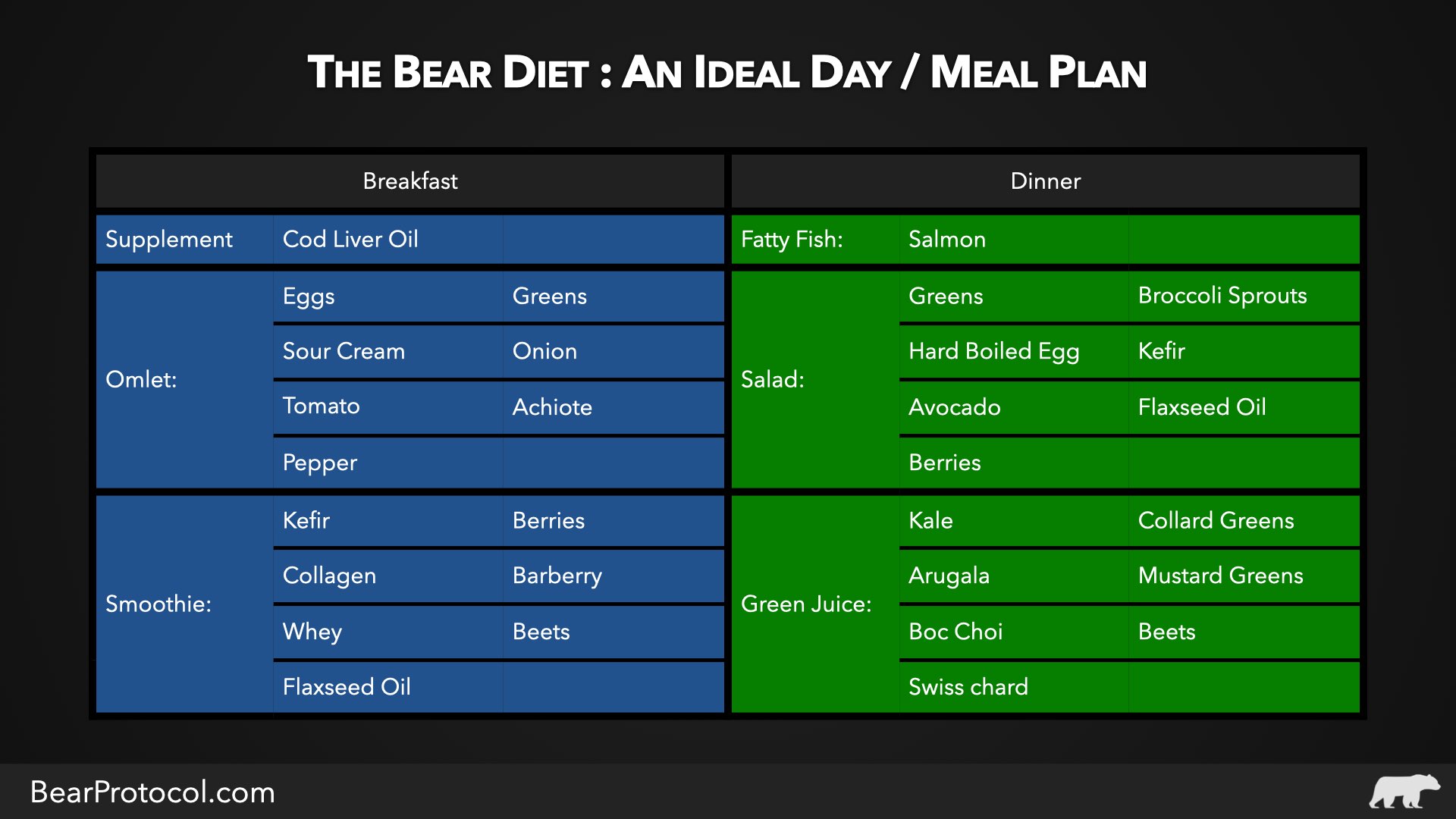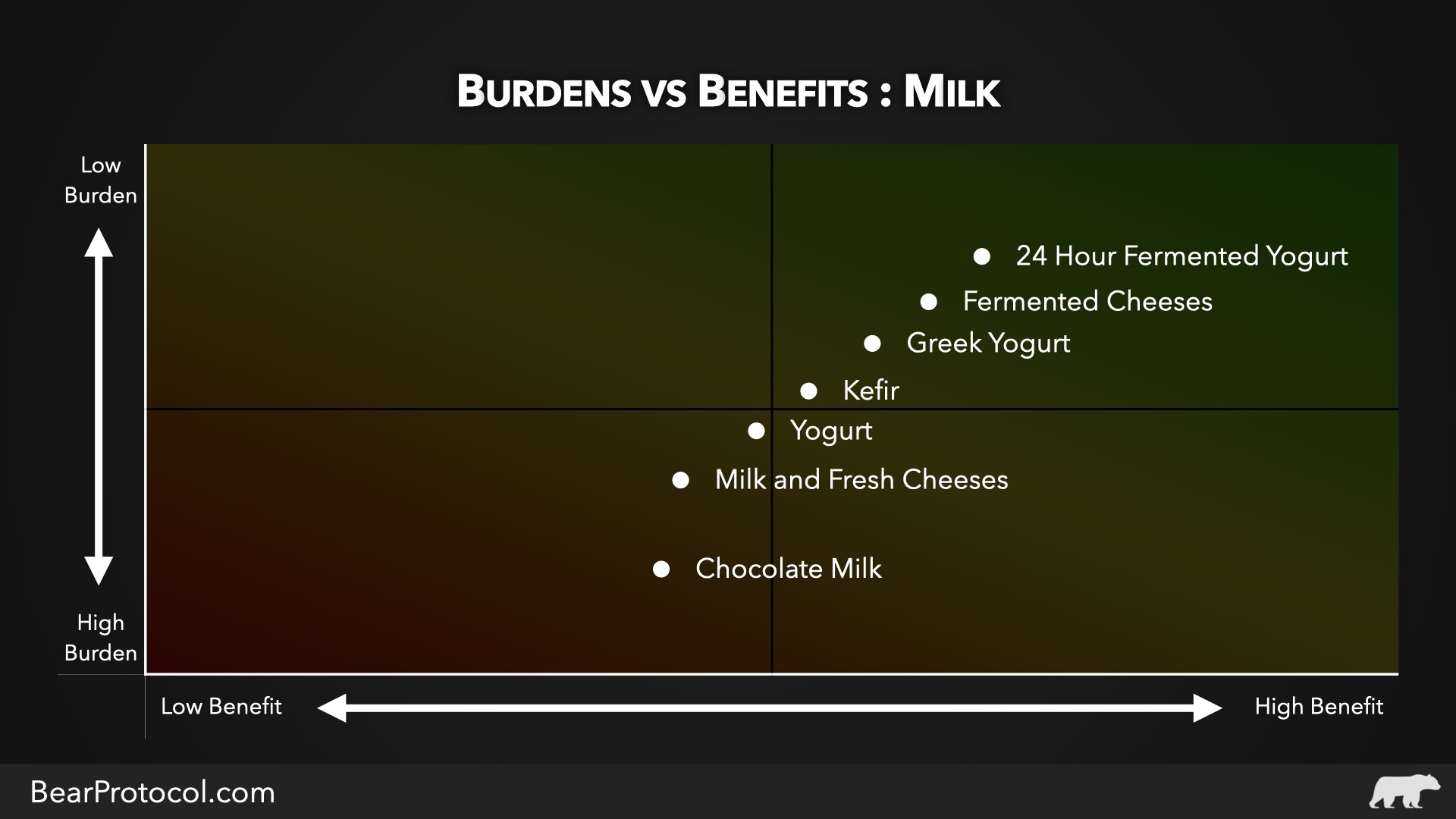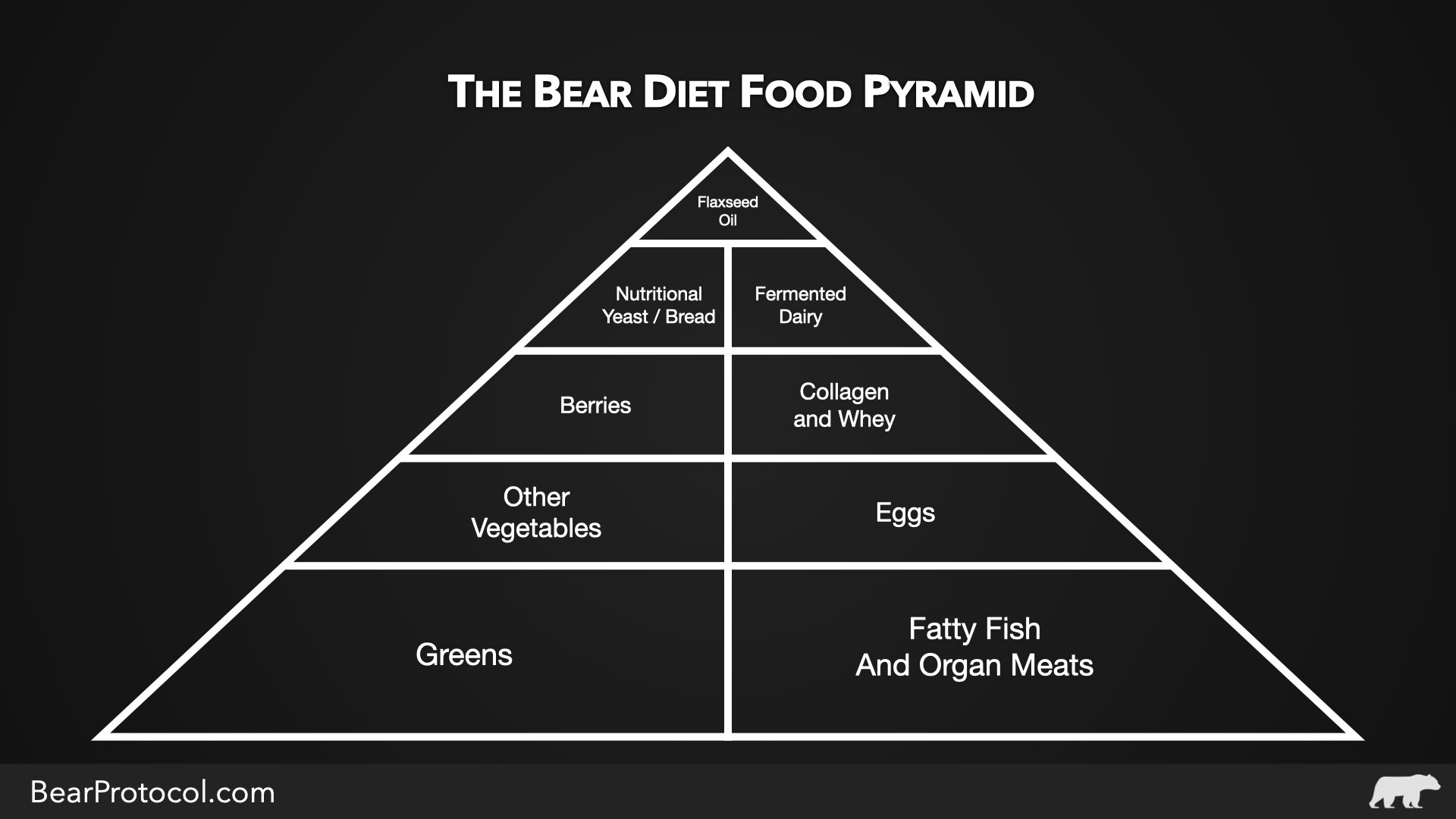The Bear Diet: The Low Burden High Benefit Diet for Healing Modern Illness and Disease Prevention
This introduction to The Bear Diet has the following parts:
- 8 Important Criteria of the Best Diet for Health, Healing, and Longevity.
- A Comparison of Popular Diets and Their Features
- The Burden-to-Benefit Ratio: A Critical Emphasis of The Bear Diet
- The Bear Diet: Allowable and Forbidden Foods
- How and When to Eat
- The Perfect Meal Plan
The Bear Diet is a powerful diet for healing, health and longevity. The diet is unique in its focus on providing the body with the highest benefit-to-burden ratio. This means it provides your body with the most possible nutrients and resources with the least amount of burden on the body’s precious resources. This focus not only provides the body with the nutrients needed to support the body’s innate healing capacity but also prevents using up resources that could be used for healing. Additionally, it’s worth noting that The Bear Diet provides the body with all essential amino acids, fatty acids, vitamins and minerals IN ABUNDANCE.
8 Criteria of the Best Diet For Health, Healing and Longevity
There are so many diets and opinions surrounding diet. There are diets for specific conditions and outcomes – like low glycemic diets or anti-inflammatory diets. There are also extreme diets that adhere to strict avoidance of certain food groups – like vegan diets and carnivore diets. And there is the more commonly recommended conservative diet often described as a balanced whole foods diet.
While many diets focus primarily on one of the following objectives, The Bear Diets ensures you meet all of them.
The 8 Criteria of the best possible diet for health and healing:
#1 Isn’t High in Burdensome Antinutrients, Enzyme Inhibitors and Natural Preservatives
Nuts, seeds, grains, and legumes are the highest sources of antinutrients (the latter three being the worst). These compounds are a very high burden on the body and its healing resources. The Bear Diet is mindful of this critical but often overlooked component. The good news is that these foods when properly prepared become free of harmful antinutrients and richer in beneficial nutrients. The bad news is in modern times these foods are almost prepared in a way that increases the burdens of these foods without increasing the benefit. More on this in a minute. Let’s look at the antinutrients.
The worst notable antinutrients:
- Oxalates: Oxalates bind and prevent the absorption of calcium, and other minerals and block the cell uptake of sulfur.
- Lectins: Lectins can interfere with the absorption of nutrients.
- Phytate / Phytic Acid): Phytic acid reduces the absorption of healing critical minerals.
- Protease Inhibitors: Protease inhibitors interfere with protein digestion by inhibiting digestive enzymes.
- Tannins: Tannins are a class of antioxidant polyphenols that can impair the digestion of nutrients.
#2 Supports A Healthy Microbiome BUT DOES NOT PROMOTE Overgrowths of Unhealthy Microbes
Nuts, seeds, grains and legumes, as well as starchy fruits and vegetables (like green bananas or potatoes) contain complex carbohydrates, prebiotics and fibers that promote microbial overgrowths in the small or large intestines. While this would be potentially great if we all had perfectly healthy and beneficial microbiomes (sadly with modern foods and antibiotics we don’t) – it is EXTREMELY harmful to add the extra toxic load on the body and liver by overfeeding our malaligned microbiomes. The Bear Diet excludes these harmful food groups and emphasizes the correctly fermented foods to reduce overgrowths and promote the innately beneficial microorganisms that have been critical to gut health and wellness for centuries.
#3 Is Anti-Inflammatory and Autoimmune Safe
Unsprouted nuts, seeds, grains and legumes present additional burdens and dangers when in comes to inflammation and autoimmune conditions. As noted previously they have a variety of harmful nutrients. These nutrients combined with the proteins of these foods trigger immune and inflammatory responses. These triggers must be eliminated. Again, this will be discussed further in a moment.
#4 Is Low Glycemic / Ketogenic
The number of chronic diseases from metabolic diseases caused by the SAD (standard American diet) is heartbreaking. Worse still, these diseases are the leading cause of death in developed countries. When we eat the way we were meant to eat we resolve this issue almost entirely. This includes complete avoidance of refined carbohydrates and ensuring that healthy protein and fat-rich foods are not avoided.
#5 Provides An Abundance of All 50+ Essential and Conditionally Essential Nutrients
Healthy and healing diets must include an abundance of the nutrients essential to healing! Extreme diets that focus on limited food groups are often missing key nutrients that are essential for complete recovery. Additionally, and a KEY FOCUS of The Bear Diet is to ensure you get an abundance of the dozens of nutrients critical to cellular, gut and nervous system healing.
It should be noted that these nutrients should be consumed in the diet whenever possible. Supplementation of critical nutrients, when necessary, should be done carefully and only when the body’s needs are measured and monitored. Okay, that said, back to the diet.
Unfortunately, almost no diets emphasize the nutrients needed to live in the modern toxic environments, homes and workplaces we spend most of our time in. The truth is we often need far more than the average daily intake and many of us (especially those with chronic illnesses) are extremely depleted and consuming an insufficient amount for healing. A few of these CRITICAL nutrients include:
- DHA
- EPA
- ALA
- Choline
- Trimethylglycine
- Glycine
- Cysteine
- Methylfolate
- Astaxanthin
- Tocotrienols
- All B Vitamins
- Electrolytes
- Major and Trace Minerals
- Phospholipids
#6 Matches What Humans Have Eaten for Millions of Years
Time and time again we can observe that fad or extreme diets that try to go too far away from the way we were made and the way we’ve lived for thousands of years – FAIL. Although it’s not the intention of The Bear Focus to focus on the ways of the past – it just so happens, that when we focus on providing the body with a diet that has the highest benefit and lowest possible burden – it looks like the diet that’s stood the test of time – and JUST AS IMPORTANTLY – how we ought to prepare our foods is the way it’s been done for centuries.
#7 Allows for All Natural In-Season Foods (When Properly Prepared … of course)
One of the nicest things about learning how foods ought to be prepared and eaten – is that you learn that there is no bad food – there are just really bad ways to prepare foods, and there are really bad imbalances in many diets.
For example, a bit of blueberries in a yogurt smoothie is great! Blueberry juice on an empty stomach is terrible! If that doesn’t make sense to you yet, it will soon.
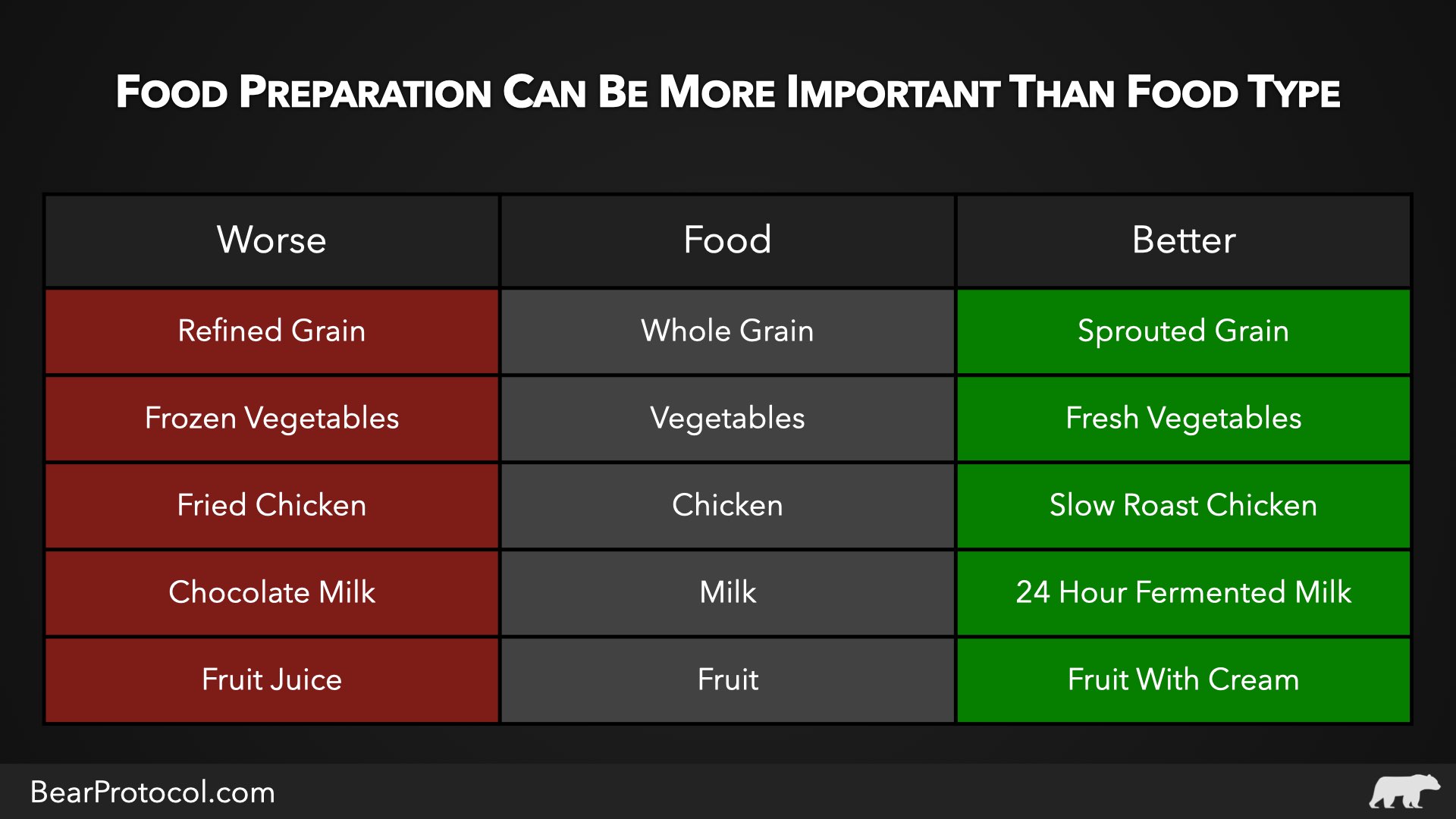
#8 Is An Organic Diet Free of Glyphosate and Other Destructive Chemicals
Finally, while it’s nearly common knowledge (but not yet common practice), it needs to be mentioned that a healing diet is completely organic and free of toxic and burdensome pesticides, fertilizers, additives, flow agents, thickeners, etc., etc.
A Comparison of Popular Diets and Their Features
Almost any diet can be helpful at the right time and for the right reason. But all diets have their pros and cons. We’ll look at the features, pros and cons of popular diets but let’s first take a quick look at what foods and food groups are allowed in the selected diets.
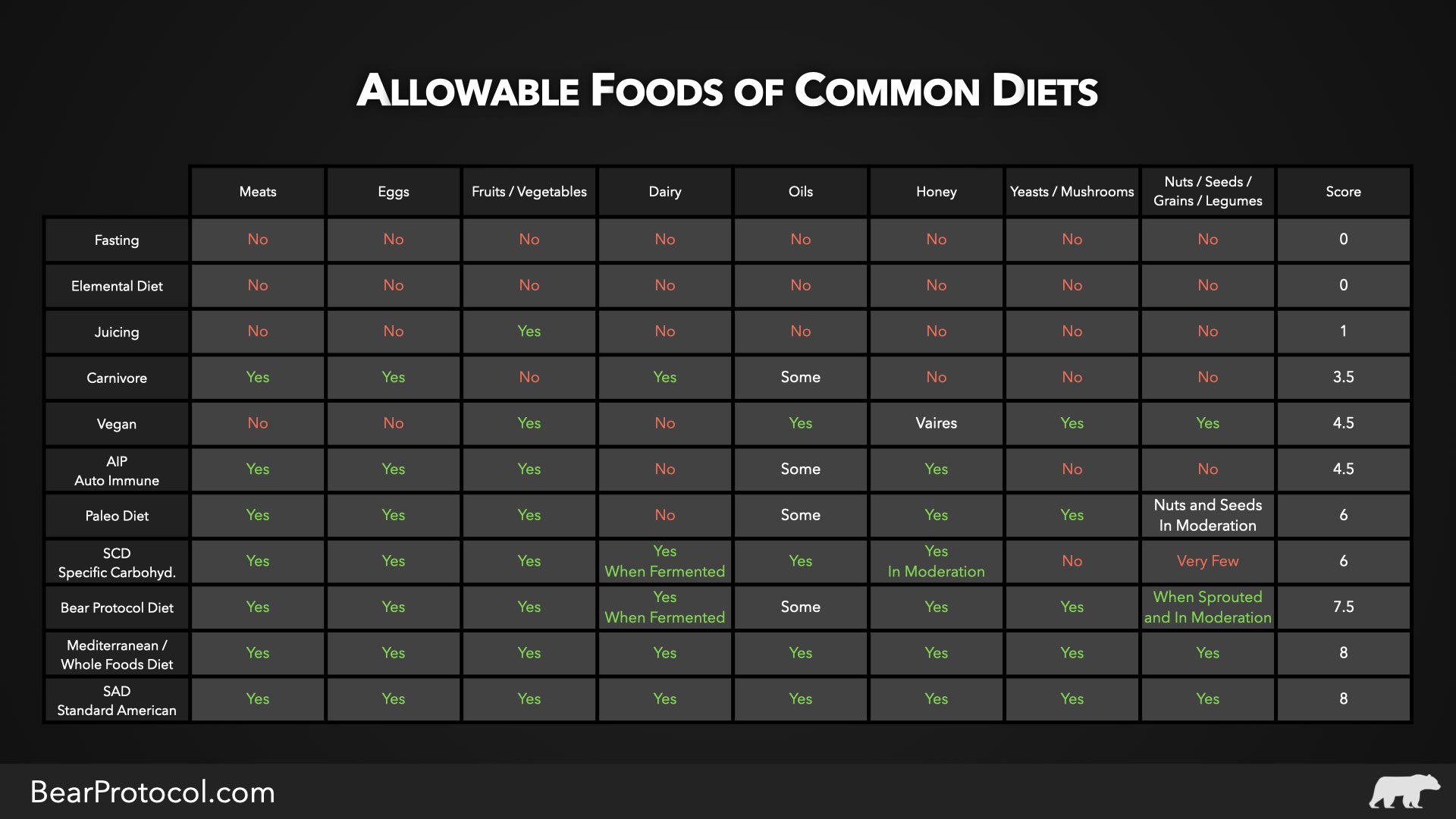
Okay, now that you have the table of allowable foods for reference – let’s move on and look at how these diets measure up to the criteria of a healing diet.
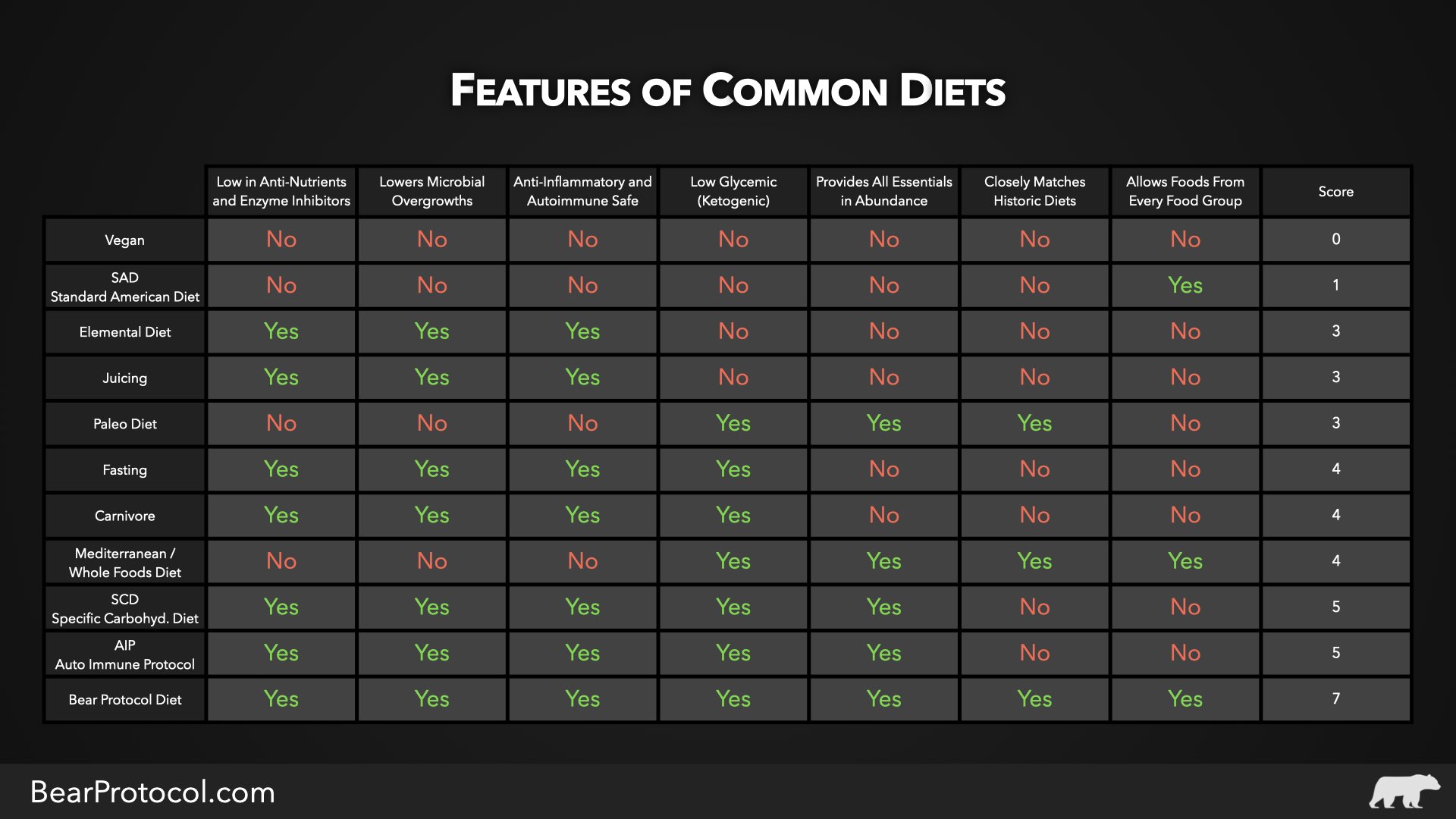
As you probably noticed, and as mentioned earlier there are several good diets to accomplish specific objectives, but when it comes to the best possible diet or way of eating – it’s important to your healing to be mindful of each of these critical factors.
The Burden-to-Benefit Ratio: A Critical Emphasis of The Bear Diet
If you’re not already, you’ll likely become increasingly aware of how important the burden-to-benefit ratio of any given food is. This is especially true when seeking to promote healing and healthspan.
What’s the burden-to-benefit ratio?
The burden-to-benefit ratio is how much a given food taxes the resources of the body to fully digest, absorb, and make the nutrients bioactive and available to the cells of the body (as well as how taxing the byproducts and the detoxification byproducts of said nutrients and their digestion) – relative to how many nutrients are a result of the digestion, absorption and assimilation.
It’s not as simple as how many amino acids, fatty acids or other key nutrients are in a food. Some foods have these nutrients packaged in a way that they are difficult or even EXTREMELY difficult to break down and absorb. While other foods have them packaged in ways they are ready to absorb and use. If you want healing or healthspan, take note – THE BURDEN TO BENEFIT RATIO IS CRITICAL.
Nutrition labels tell you what’s inside a given food but they don’t tell you a thing about what it will take to unlock and access those nutrients.
Let’s look at a visual of the burden-to-benefit ratio.
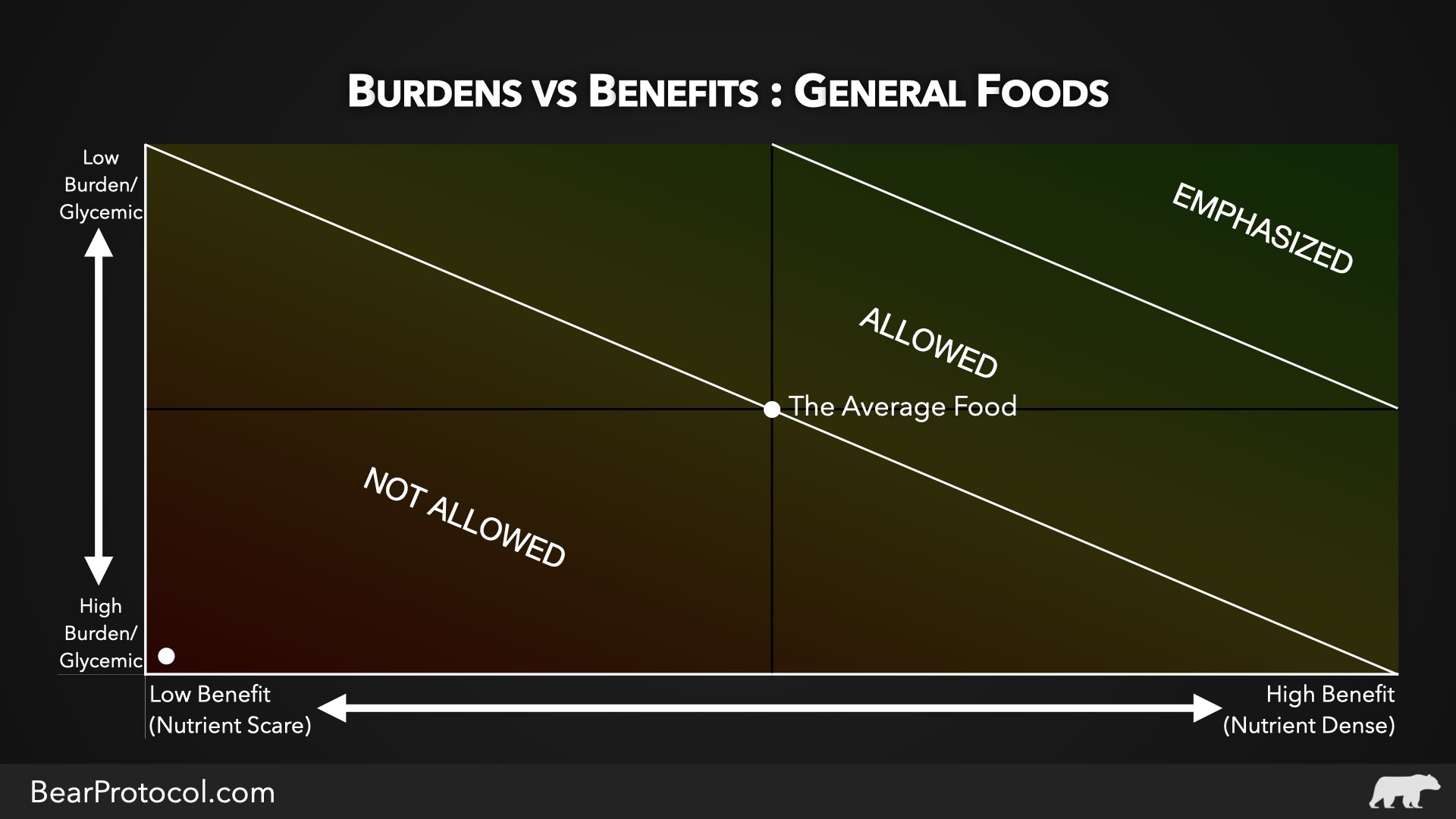
Note that in the visual above foods that have a higher than average benefit (think nutrients critical for healing) belong right of the center line. And if foods have a lower than average volume of critical nutrients or lower than average benefit they fall to the left of the center line on the chart.
On the vertical access, we have high vs low burden.
*Please note that if a food is a higher glycemic food or has a higher impact on raising blood glucose then that will raise the burden of that food. We can discuss the burdens of elevated blood glucose later – but for now, just know that the ability for a food to raise blood glucose is considered among the burdens of a food.
Okay, moving on, and as you probably noticed, if food has a lower burden it goes above the center line. If a food has a higher than average burden it falls below the center line.
This chart enables you to see that foods are split diagonally into the allowed foods (foods that have a lower than average burden-to-benefit ratio) and not allowed foods (foods that have a higher than average burden-to-benefit ratio.
Also note that foods that are both above average in benefit but below average in burden are ‘Emphasized’. Most foods don’t meet this criteria but gratefully there are a handful that do and they are your best friends when it comes to healing and healthspan.
Let’s take a look at a few examples.
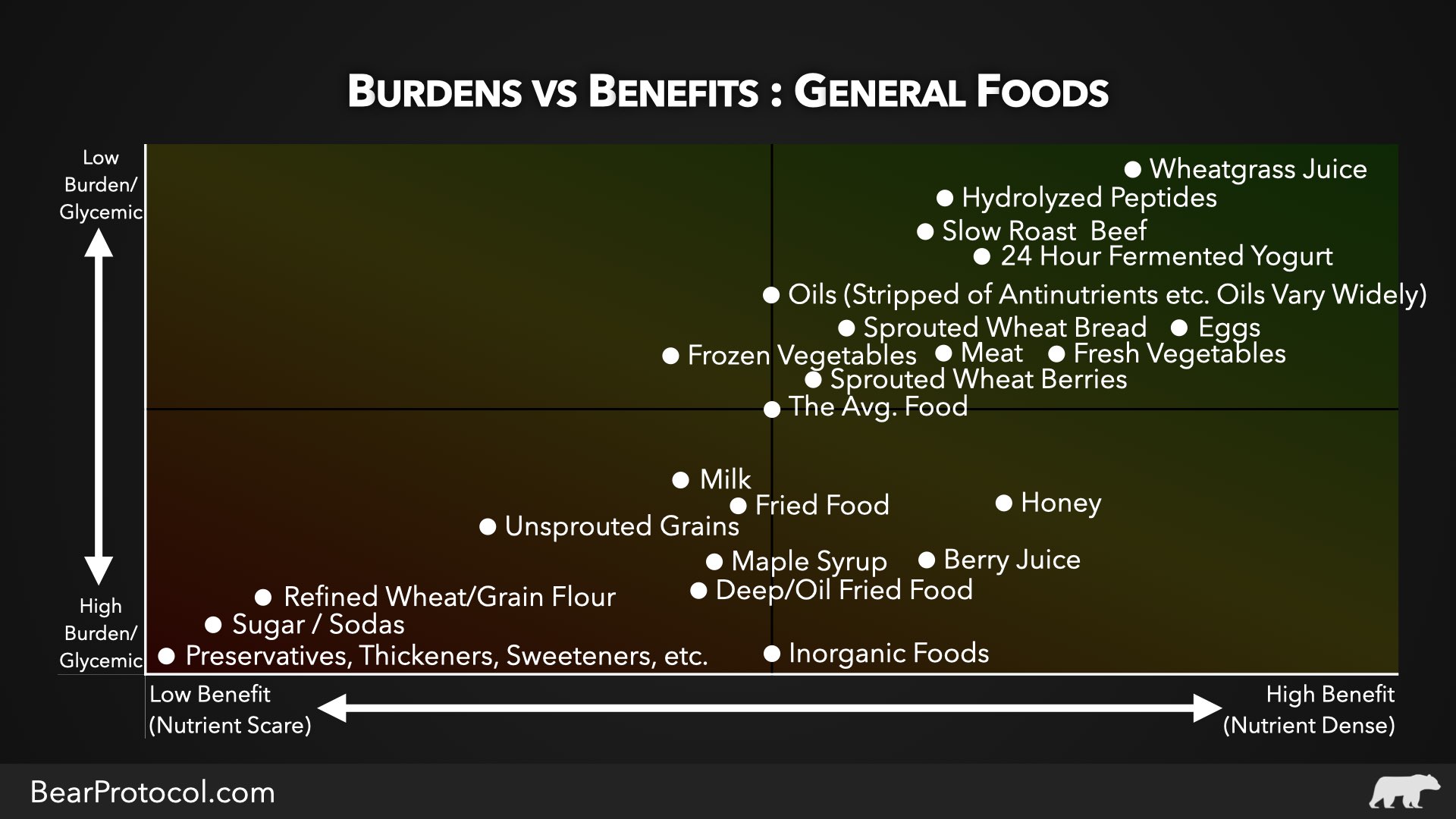
When you plot foods by their burden-to-benefit ratio relative to one another, it becomes clear – foods prepared the modern way become less nutritional/beneficial and more burdensome as well as higher in glycemic load. Equally noteworthy is the fact that the same foods, when prepared in the methods proven over centuries, become more nutritious while also becoming a lower burden on the body’s precious resources.
We’ll look at a few more charts of the burden-to-benefit ratio below when we discuss individual food groups.
Okay, now that we understand the burden-to-benefit ratio, let’s take a look at what you really want to know.
What foods should I be eating? And which ones should I avoid?
The Bear Diet: Allowable and Forbidden Foods
Let’s jump in and take a look at the foods that are emphasized, allowed and not allowed in each main food group.
Meats, Organ Meats, Meats, Bone Marrow, Collagen and Gelatin
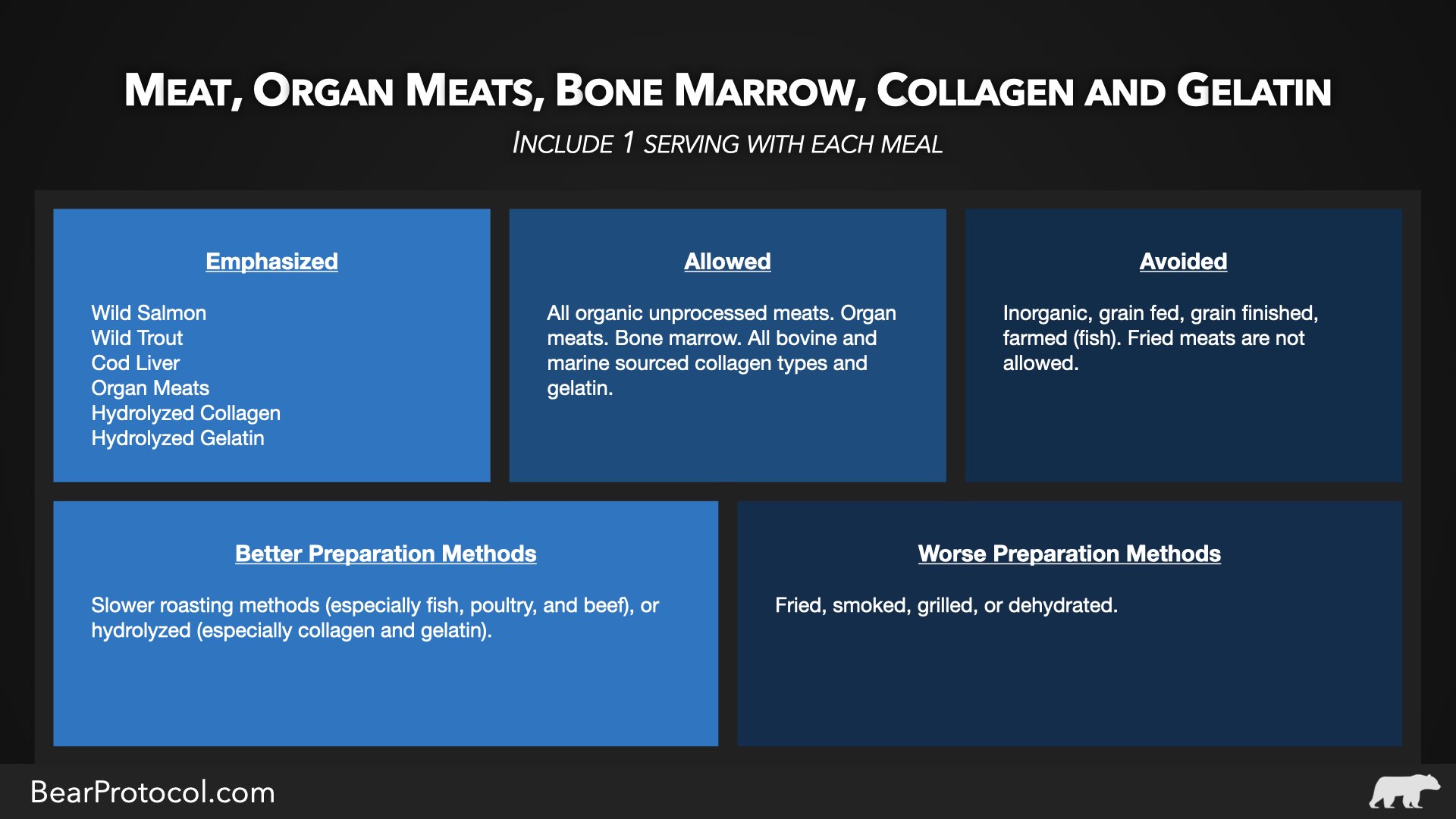
Meats
Meats are allowed and are an important part of The Bear Diet. An emphasis is placed on the freshwater fatty fish – Salmon and Trout. The DHA and EPA Omega 3 fatty acids found in these fish are critical in healthspan, disease prevention and chronic illness recovery. It’s worth noting that you can also get good amounts DHA and EPA from saltwater fish like Mackerel, Herring, Anchovies, and Sardines. And while grass-fed beef and free-range chicken eggs can support your DHA and EPA dietary intake they lack the abundance of these nutrients that become essential under conditions of illness or aging.
Any meats that are inorganic, grain-fed, grain-finished, or processed are not permissible in the diet.
Meats preserved via freezing or stored in their own oils are allowed.
Organ Meats and Bone Marrow
Organ meats are certainly among the foods with the highest benefit-to-burden ratio. Liver, in particular, is an especially nutrient-rich food that gives an enormous bang for its buck. Working cod liver, beef liver or chicken liver into your diet is strongly recommended. It doesn’t need to be a daily staple but if you’re able to work some organ meats into your diet your body will thank you.
Bone marrow is also a powerful food as it provides bioactive peptides among other nutrients that can help stimulate healing and repair. Some diets emphasize bone marrow broth as a way to help heal and repair the gut.
Collagen and Gelatin
Hydrolyzed collagen and gelatin peptides round out the third and fourth sources for bioactive peptides (fish and bone marrow being the other two). These peptides provide a simple way to get powerful and essential amino acids in the daily diet. Note there are 20+ types of collagen peptides and they each offer different benefits to the body. For example, type 2 collagen impacts gut healing in ways that the more common type 1 or type 3 do not. The same is true for gelatin peptides. So consider trying different types of peptides as well as different sources such as marine-sourced collagen – and see which of them benefit you most.
Eggs
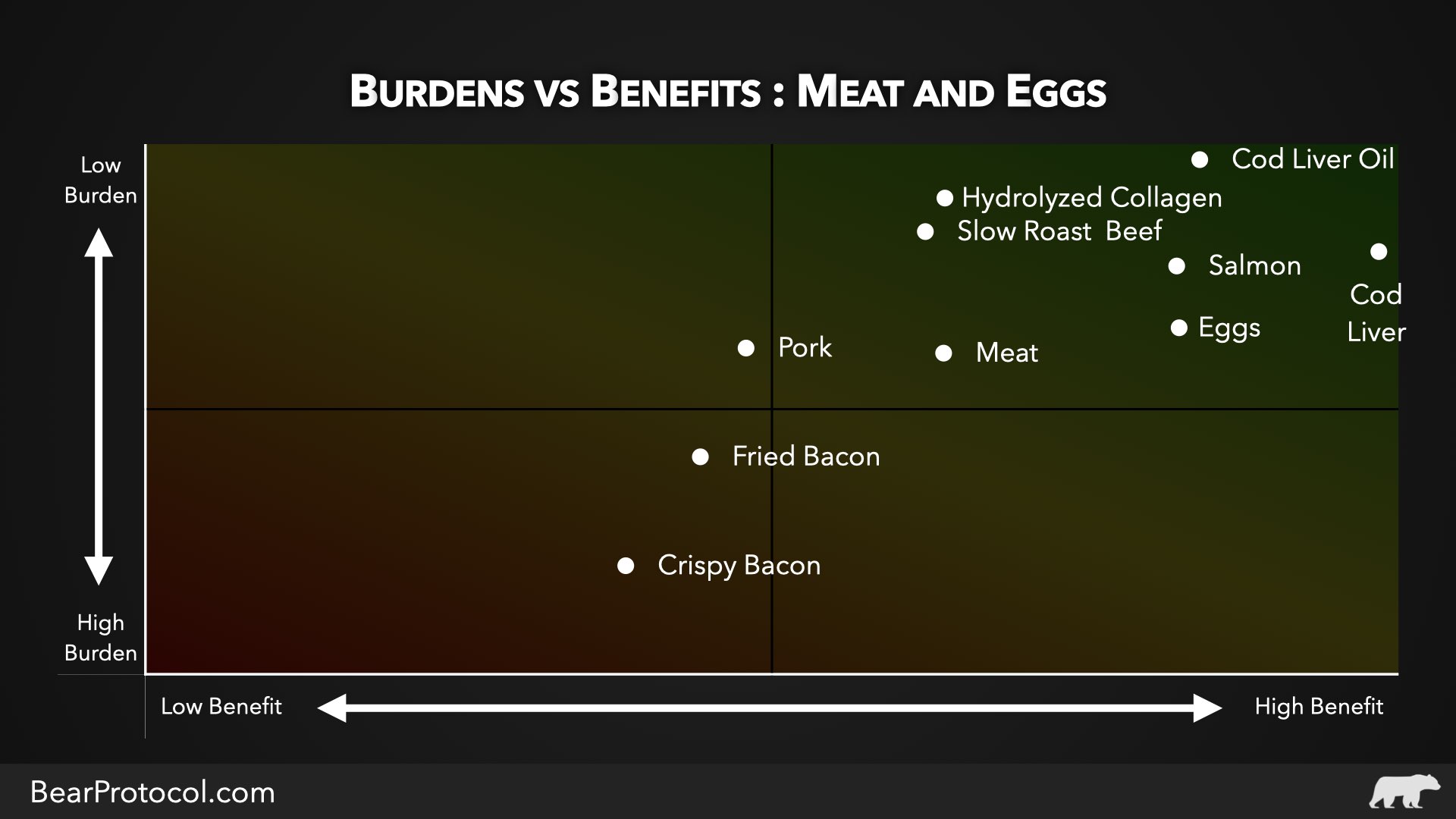
Eggs are another very high benefit to burden food. They are very nutrient-rich and a powerful way to get an abundance of choline in the diet (which is critical to healing and preventing many chronic illnesses including autoimmune, inflammatory or age-related illnesses).
Eggs should be organic and preferably free-range.
Fruits and Vegetables
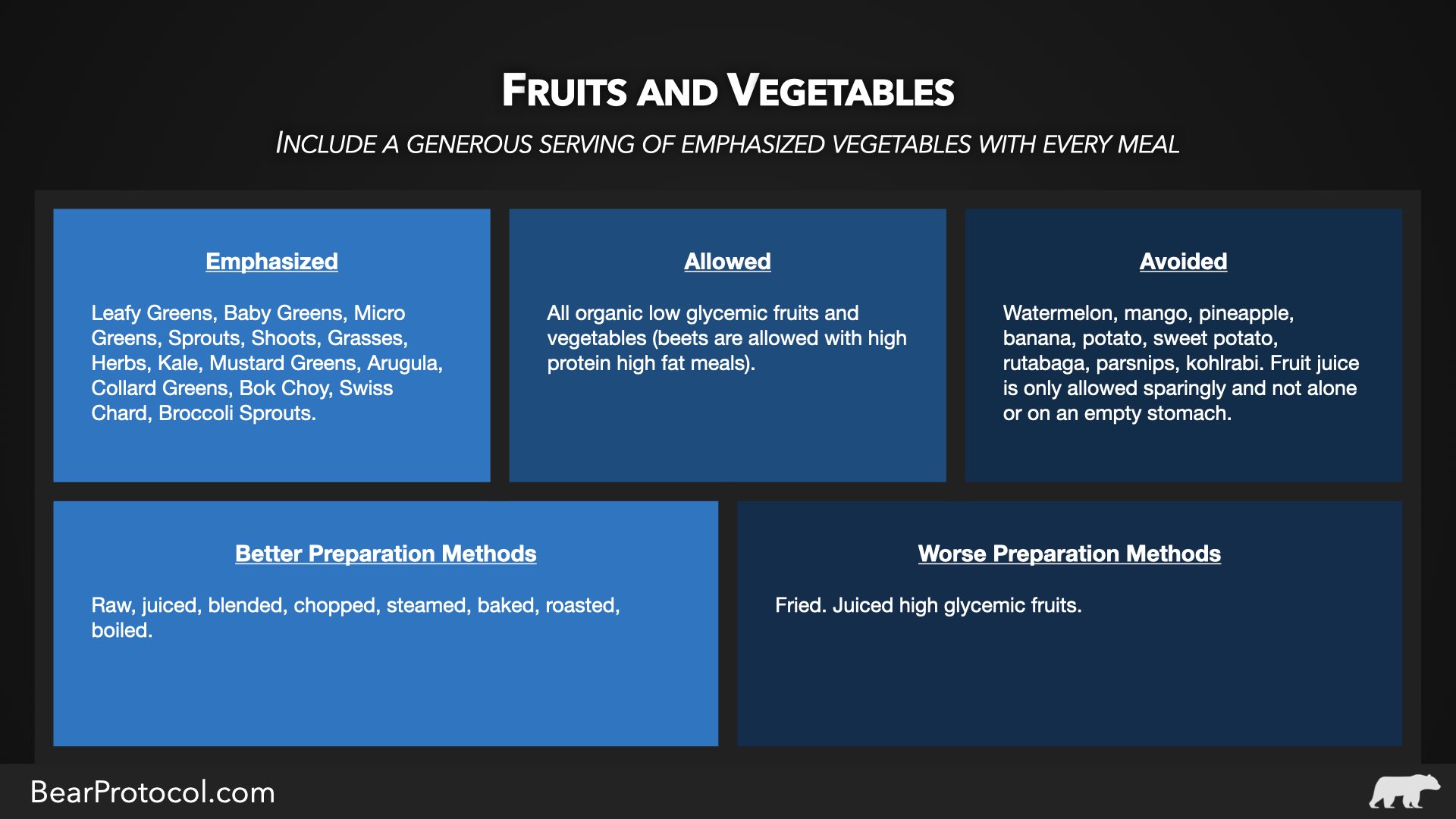
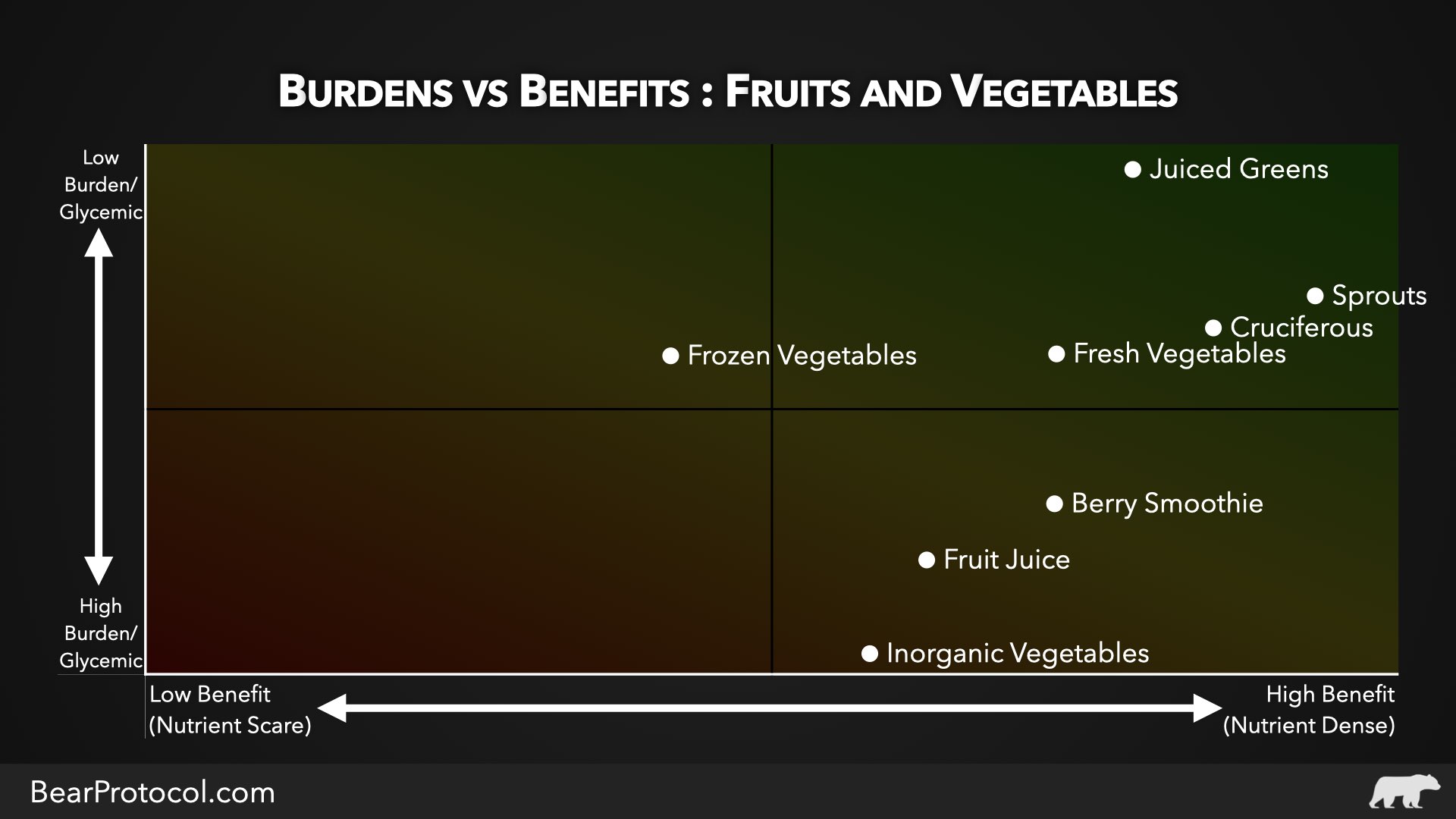
Vegetables should be consumed as part of every meal! They should be the cornerstone of the diet and every meal! They should be juiced, blended into smoothies, used in omelets, eaten alone raw, baked, steamed, and made into soups, salads, and salsas.
#1 Green Cruciferous / Brassica Vegetables
There should be a strong emphasis on leafy green or sprouted cruciferous (also known as Brassica) vegetables. There are seven common cruciferous greens – we’ll refer to these as the SUPER SEVEN. Keep your favorites on hand and use them wherever desirable and as often as possible. The super seven are:
- Arugula (great raw)
- Broccoli Sprouts (great raw)
- Radish Sprouts (great raw)
- Mustard Greens (best steamed or cooked)
- Kale (best steamed or cooked)
- Collard Greens (best steamed or cooked)
- Bok Choy (best steamed or cooked)
There are also some leafy greens that you want to stay away from because they can be the very highest in oxalate levels. Specifically, you want to avoid leafy greens from the Amaranthaceae family:
- Amaranth: High in oxalates.
- Lamb’s Quarters: High in oxalates.
- Beet Greens: High in oxalates.
- Spinach: High in oxalates.
- Swiss Chard: High in oxalates.
#2 Leafy Greens, Micro Greens, Sprouts, and Shoots Not from the Amaranthaceae family (even if not Cruciferous / Brassica)
In addition to leafy green Brassicas, a special emphasis should be on other non-Amaranthaceae family leafy greens, micro greens, sprouts, and shoots. Including
- Romaine Lettuce
- Green Leaf Lettuce
- Baby Kale
- Baby Collards
- Baby Radish Greens
- Alfalfa Sprouts
- Buckwheat Sprouts
- Wheat Grass
- Sunflower Shoots
#3 Non-Leafy Green Low Glycemic/Starch Cruciferous Vegetables
- Broccoli
- Cauliflower
- Brussel Sprouts
- Cabbage
- Radishes
- Watercress
- Horseradish
- Broccolini
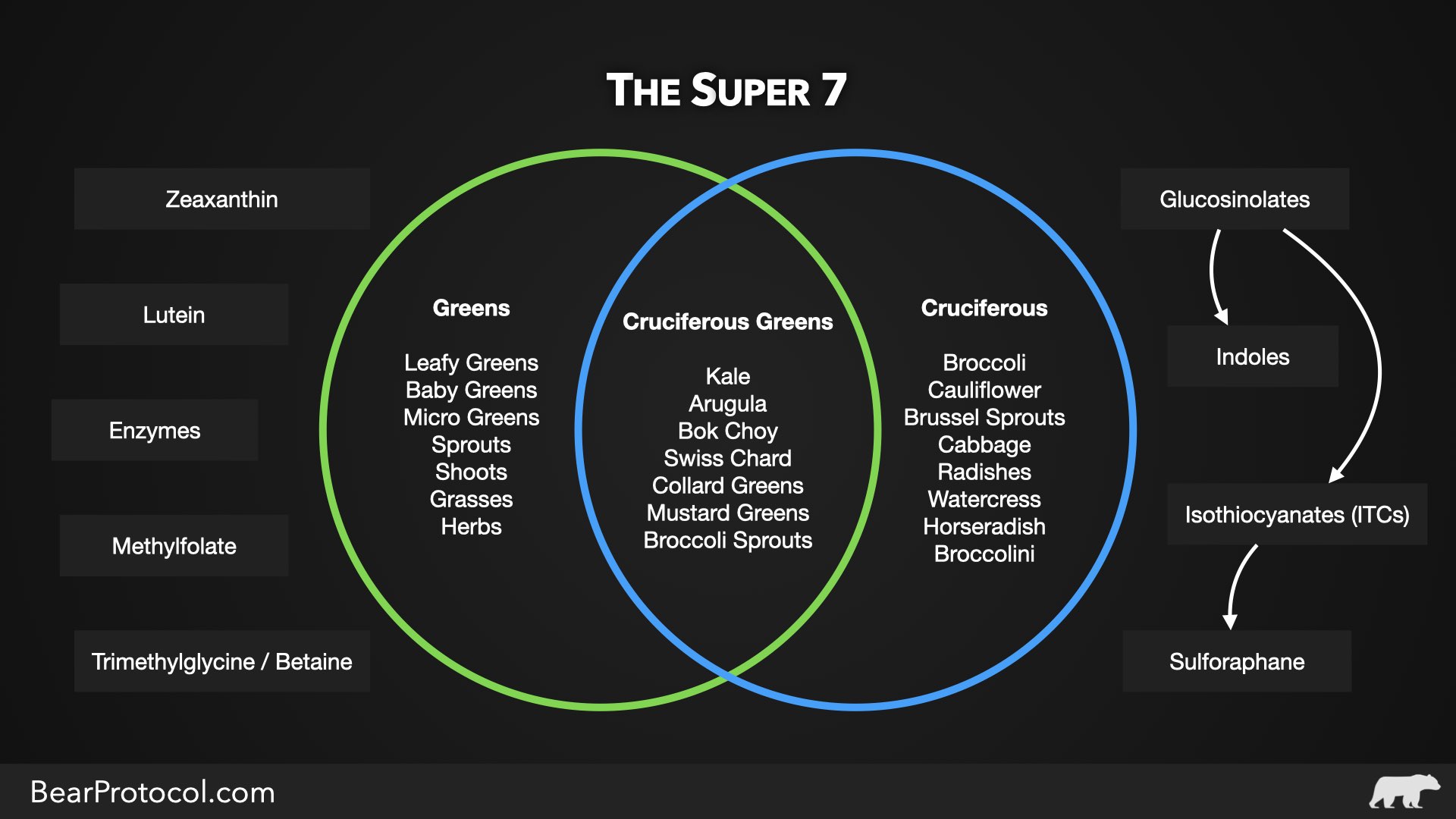
#4 Beets
While the emphasis within vegetables (and any food group for that matter) is placed on low glycemic index foods, beets are an exception. Beets are the mid-glycemic root vegetable that is emphasized. Of course, you want to avoid raising blood glucose by never eating beets on an empty stomach and always eating it with protein-rich and fat-rich foods.
Why beets?
While cruciferous leafy greens are quite powerful at removing biotoxins from the body – they don’t hold the coveted #1 spot. That belongs to beets. So when you have the opportunity add beets to your steamed or boiled veggies (avoid beets raw as explained below). This will have almost no impact on blood glucose when eaten with meals high in protein, fat, and fiber AND quite importantly it will help to remove biotoxins that can be extremely challenging to remove without the help of beets and cruciferous leafy greens (kale and collards are best behind beets at biotoxin removal).
*Please not that beets are high in oxalates and should therefore be steamed or boiled to reduce the oxalate levels. A big bonus is that steamed beets are superior at removing biotoxins than raw beets.
#5 Healing Vegetables To Spice Up Your Meals
- Turmeric (high in curcumin)
- Ginger
- Onions (high in quercitin and fisetin)
- Garlic
Vegetable Juicing
It is highly recommended to juice vegetables whenever possible to provide the body with an abundance of the powerful nutrients, enzymes, and antioxidants only found in vegetables. It is worth noting that multiple successful cancer and healing protocols lean heavily on vegetable juicing as a means of stimulating and providing necessary nutrients for detoxification and healing.
Avoid Less Helpful High Starch Vegetables
Some vegetables should not be emphasized and should be avoided in any significant amounts. This is due to the starch content and/or the glycemic index of these foods. They include
- Corn (see also grains)
- Peas (see also legumes)
- Potatoes
- Sweet Potatoes
- Rutabega
- Parsnips
- Kohlrabi
Fruits
Among the fruits, berries (including grapes) have the best burden-to-benefit ratio. Not only do berries have a lower glycemic index but they are the most abundant source of three powerful antioxidants – anthocyanins, resveratrol, and berberine.
But …
It’s important to enjoy berries WITH a few guidelines that will keep them from raising your blood glucose:
- Not on an empty stomach but with a meal that includes a good source or protein, fat and fiber.
- Avoid juicing. For example, try to stick to adding the whole berries to a kefir smoothie rather than simply adding berry juice.
- Ripe and in-season berries will have less prebiotic sugars than when berries are unripe or picked before ripening and shipped.
So which should you be eating?
- Blueberries (Anthocyanins, Quercetin, Resveratrol)
- Blackberries (Anthocyanins, Quercetin, Resveratrol)
- Raspberries (Anthocyanins, Quercetin, Resveratrol)
- Strawberries (Fisetin, Anthocyanins, Quercetin, Resveratrol)
- Cranberries (Anthocyanins, Quercetin, Resveratrol)
- Cherries (Anthocyanins, Quercetin, Resveratrol)
- Red Grapes (Anthocyanins, Quercetin, Resveratrol)
- Acai Berries (Anthocyanins, Resveratrol)
- Elderberries (Anthocyanins, Quercetin, Resveratrol)
- Mulberries (Anthocyanins, Resveratrol)
- Barberries (Berberine)
- Goji Berries (Zeaxanthin)
- Huckleberries (Anthocyanins, Quercetin, Resveratrol)
- Boysenberries (Anthocyanins, Quercetin, Resveratrol)
Dairy
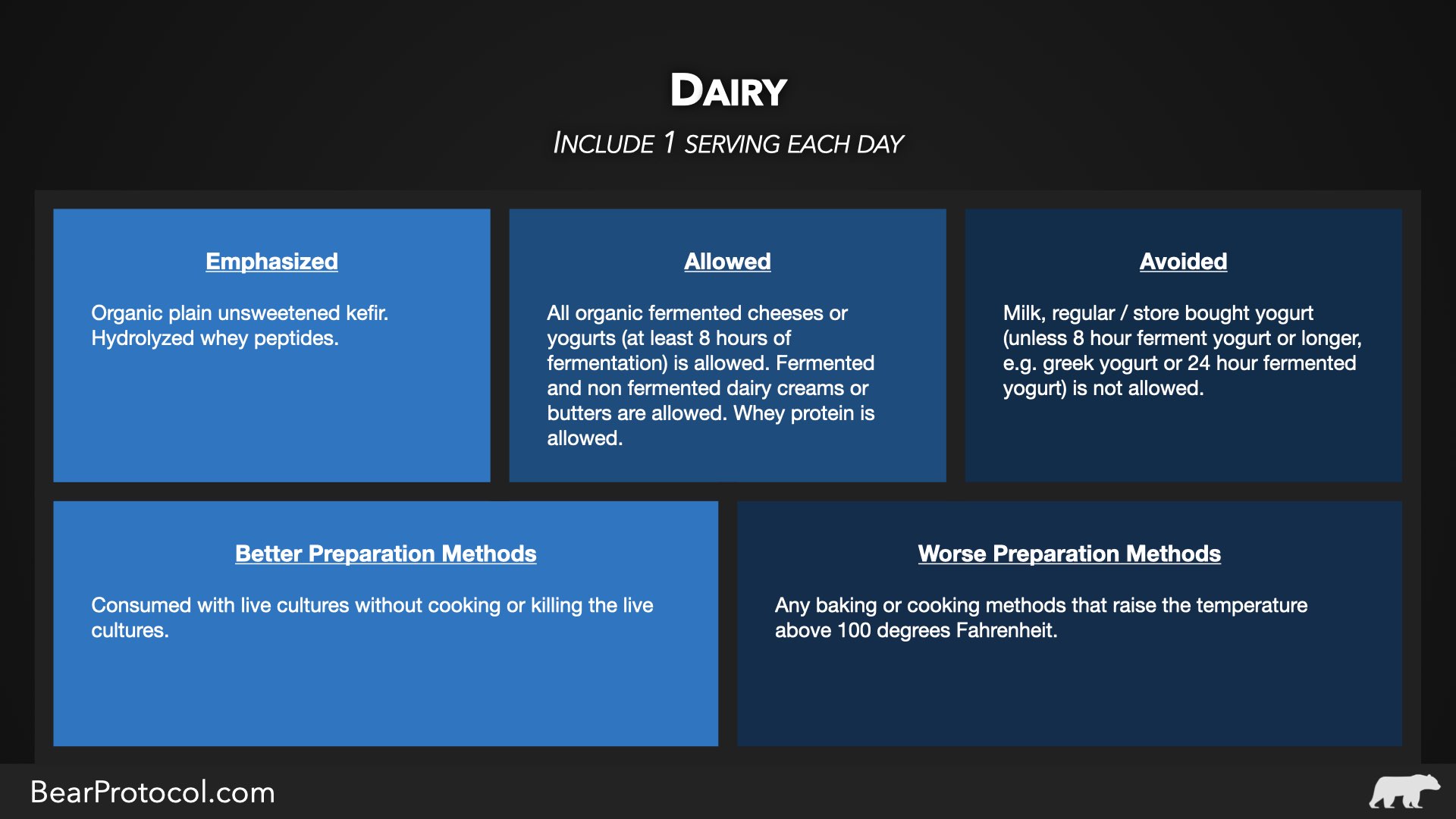
Dairy can be broken down to four very different subgroups – milk, milk fat, fermented dairy and whey. Let’s take a quick look at each.
Milk
Cow’s Milk contains two challenging nutrients – lactose and casein. Lactose can be challenging to digest and absorb and thus promotes overgrowths or flares of microbial overgrowths of the gut. And unfortunately, lactose-free milk just means the lactose has been broken down to glucose and galactose, which raises the glycemic index of the milk.
In the case of casein, it presents challenges in digestion and is second only to gluten when it comes to intolerance.
For these two reasons, cow’s milk is not permissible – except in the three following exceptions.
Milk Fat (ghee, butter and cream)
The fat from milk is free of the challenging milk protein (casein) and milk sugar (lactose). Since cream and butter are not pure milk fat and still have burdensome unfermented milk neither are allowed. Ghee which is 100% milk fat and sour cream which has been fermented are both allowed.
In other words:
Butter and cream are better than milk but …
Only ghee and sour cream are allowed.
Fermented Milk: Kefir, Yogurt, and Cheese
As mentioned fermenting cream makes the cream better. Likewise, fermenting milk makes the milk better. Milk can be fermented to make kefir, yogurt or cheese.
Not only does fermenting remove the biggest burdens in milk. Fermenting creates an abundance of probiotics and more importantly an abundance of enzymes and short-chain fatty acids. Both of which are byproducts of the live cultures in the fermenting milk.
Store-bought yogurt usually spends a minimal amount of time fermenting (around 4 hours) and therefore too much burden remains in these yogurts and they should be avoided. Greek yogurt on the other hand, often spends about 8 hours fermenting and since fermentation takes place at an exponential rate – Greek yogurt has a far better burden-to-benefit ratio and is allowed. Better still, would be store-bought or homemade yogurt that has been fermented for 24 hours. At this point, the yogurt has untraceable amounts of lactose and AN ENORMOUS number of probiotics and their beneficial byproducts.
Kefir is a little different than yogurt in that it usually ferments at room temperature where as yogurt often ferments at temperatures close to body temperature. So Kefir (unlike Greek yogurt) always needs a full 24 hours of fermenting to meet the burden-to-benefit ratio you should be seeking. The good news is that all store-bought kefir has usually been fermented to these levels.
Please note that if you do not tolerate yogurt or kefir they should be avoided until you are further healed and can tolerate these foods and their probiotics.
Whey
During the fermentation process of milk it produces a protein called whey. Whey is not the harmful casein. Additionally, whey is a fantastic source of L-cysteine which is necessary for glutathione production in the body (if you’re not familiar with glutathione yet, just know – IT”S CRITICAL TO HEALTH). For this reason, whey is a great food.
*Note that whey in abundance can trigger cellular growth (and the MTOR pathway) similar to how excessive glucose can. Therefore those with cancer, leukemia or other metabolic disease might consider limiting or avoiding whey in addition to glucose.
Yeast and Mushrooms
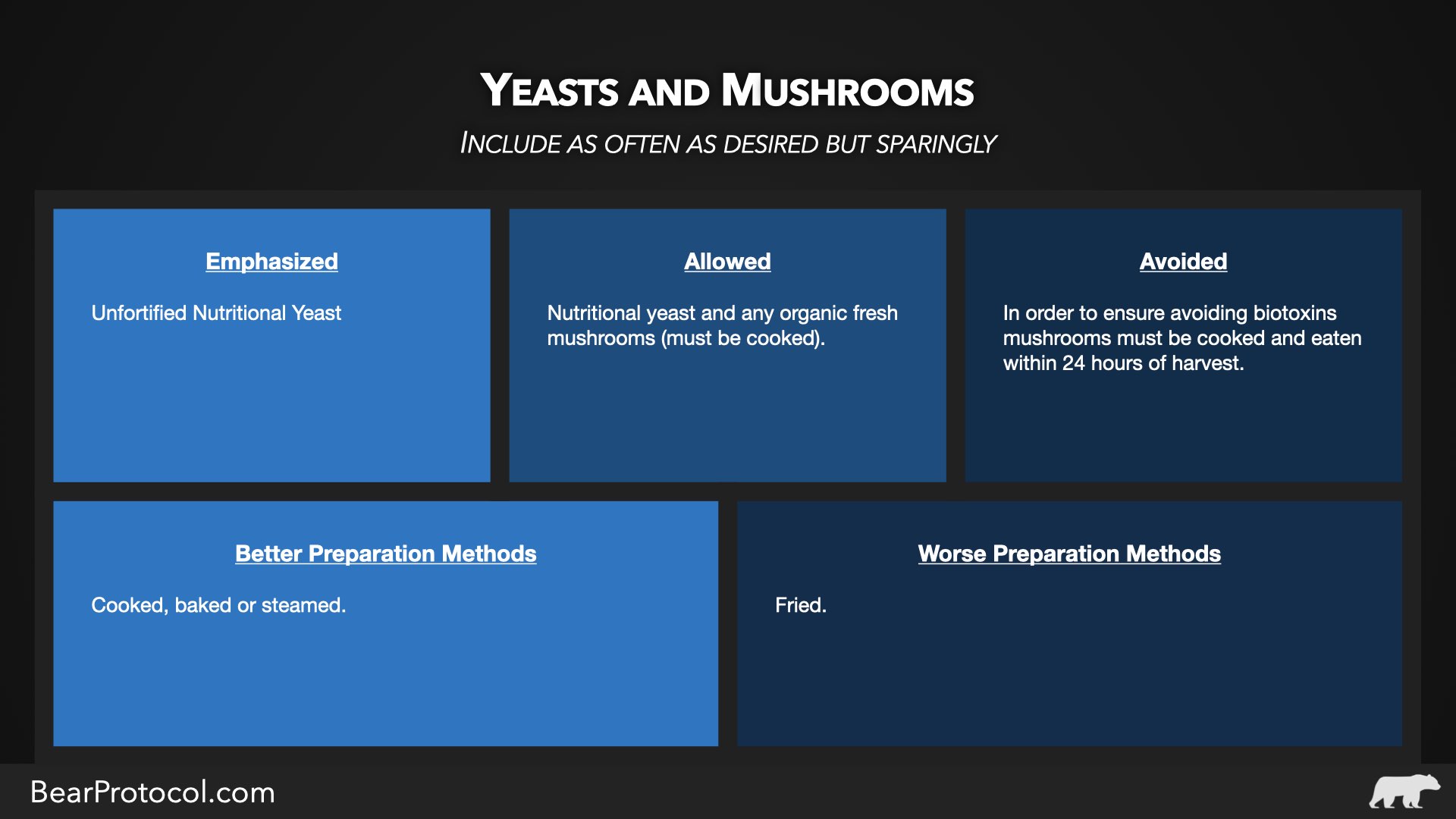
Yeast
Saccharomyces cerevisiae is a species of yeast that has played a tremendous role in food through the ages. It is often referred to as ‘Baker’s Yeast’ as it is the yeast used in the fermentation of bread dough. It is also, however, the yeast used to make wine by fermenting grape juice. Additionally, some strains of Saccharomyces cerevisiae are also used to ferment and make kefir from milk. We discuss bread, wine and kefir when we discuss grain, fruit, and dairy.
But there’s another quite common way to consume Saccharomyces cerevisiae – plain.
That’s right, and you’ve probably heard of it or tried if before. It’s called nutritional yeast or if grown during the wine-making process, brewer’s yeast. In The Bear Diet, the more nutrient-dense nutritional yeast is the yeast we emphasize (over brewer’s yeast). Not only is it more nutrient dense but people come to enjoy its taste and flavor.
It’s worth noting that Saccharomyces cerevisiae is a critical superfood. We won’t take the time to discuss the critical role B vitamins play in health and healing but just note that there are 8 of them – and each of them are essential. It’s also noteworthy that the B vitamins are not needed in equal amounts. Niacin (vitamin b3), for example, is needed in volumes roughly 1,000 times greater than cobalamin (vitamin b12). Thirdly, the b vitamins are needed together, and they work as a group. The work of one impacts the work of all the others.
So why bring up B vitamins with Saccharomyces cerevisiae?
The B vitamins were all discovered together in a culture of Saccharomyces cerevisiae. And it just so happens that Saccharomyces cerevisiae is the most potent source of the B vitamins. Unfortunately, the modern lifestyle taxes our B vitamin supply and if our microbiomes and diets lack the correct amounts of Saccharomyces cerevisiae – we won’t be able to keep up with the demand of these precious vitamins. The final point, is that Saccharomyces cerevisiae produces the b vitamins in a ratio that matches the needs of the human body.
Mushrooms
Mushrooms can have extremely potent properties. They can be used in ways that help or hurt your health. Each mushroom is different in its impact on the body and it would be prudent to only use these with caution and in ways that have been proven with time.
Although mushrooms are one of the allowed food groups – there are two strong recommendations.
- Only eat fresh mushrooms
- Always cook your mushrooms
The reason you want only fresh cooked mushrooms is due to the bacterial biotoxins that can be found on the mushrooms. Some of these toxins can be very damaging to the body. The fresher the mushroom the less time bacteria have to proliferate on the mushroom and create toxic byproducts. And heat and cooking breaks down some of the most toxic byproducts.
Honey and Syrup
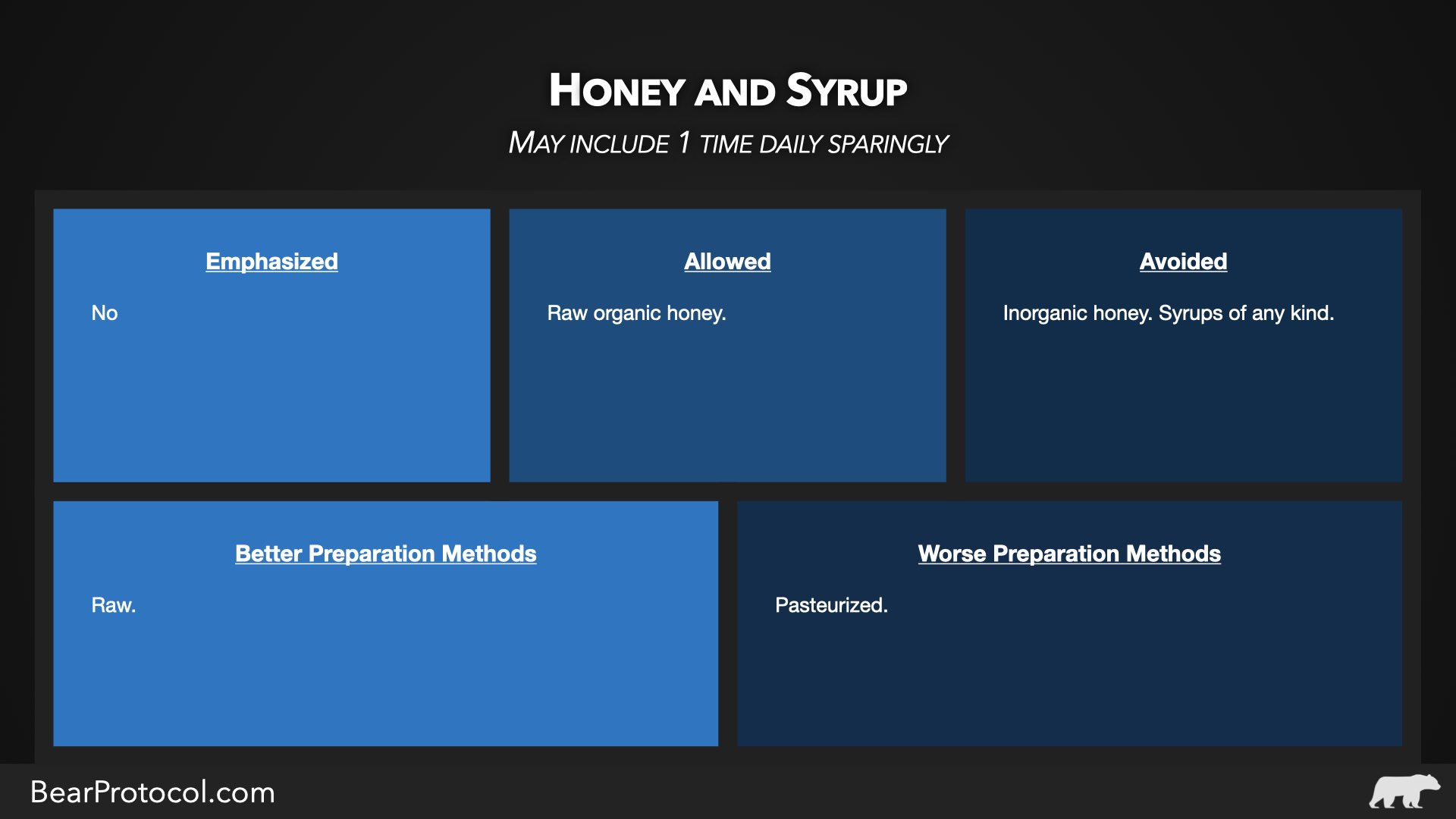
Honey
Raw organic honey is an allowable food (and even emphasized in small amounts) but has a pro, con and limitation. The pro is that honey provides natural enzymes and besides its negative impact on blood glucose, it has almost no other burden as its macronutrients are almost an even split between the monosaccharides fructose and glucose (outside of a very small amount of sucrose). The con, already noted, is that the sugar in honey does raise blood glucose levels (although it is best among all sweeteners). This brings us to the limitation – honey should only be used sparingly with meals that are high in protein and fat – and of course that means never alone or on an empty stomach (including at the beginning of the meal).
Oils
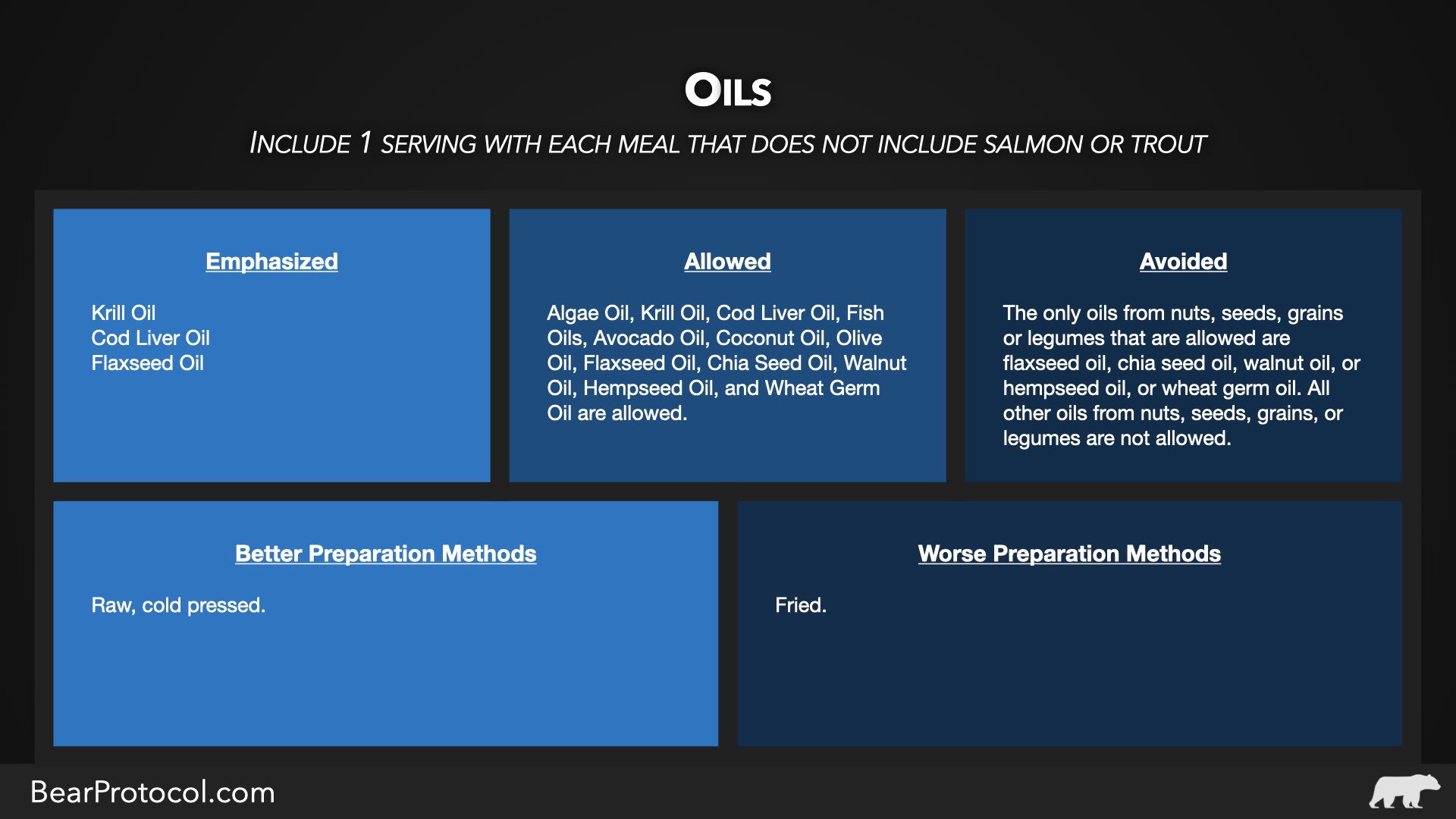
There are a limited number of healthy oils. And a whole lot of unhealthy oils. Let’s break them down.
Fish Oils / Cod Liver Oil
Fish oils are all allowed and belong under ‘meats’ as they are simply a part of the meat. This includes cod liver oil, which is emphasized for its DHA, EPA, resolvins, and Vitamin D content.
Krill Oil
Krill oil is technically an animal product. It is a source of DHA and EPA but at much lower levels than cod liver oil. It is emphasized due to its astaxanthin content. If you’re eating your salmon and trout at dinner then you won’t need krill oil, but if you’re not in optimal health taking krill oil with dinner can be an alternative way to get at least a portion of the DHA, EPA and astaxanthin you would have gotten with your salmon (more on meal planning below).
Algae Oil
Algae oil is the only plant source of DHA and EPA and it’s the original source of DHA and EPA. Salmon gets its DHA and EPA from eating krill and krill gets its DHA and EPA from algae. Like krill oil, algae oil does not have nearly as high of a concentration of DHA, EPA or vitamin D as cod liver. Therefore cod liver oil is emphasized over algae oil.
Fruit Oils: Avocado, Olive and Coconut
All oils derived from fruits are allowable. These are usually avocado, olive and coconut oil. It’s worth noting that coconut oil is the easiest to absorb oil and a good place to start for those with fat malabsorption.
The Allowable Vegetable or ‘Seed’ Oils: Flaxseed, Chia Seed, Walnut, Hemp Seed, and Wheat Germ
The name ‘seed oil’ or ‘vegetable oil’ seems to be a bit of a misrepresentation as it refers to oils taken from nuts, seeds, grains or legumes, but at any rate, most are not allowed. The unfortunate truth is that these oils often contain high amounts of inflammatory fatty acids and too low of anti-inflammatory fatty acids to make up for it. There are just a few exceptions.
- Flaxseed Oil: Flaxseed oil has the best lipid profile of any seed oil. It’s one of only two seed oils that has more anti-inflammatory Omega 3s than inflammatory Omega 6s (the other being chia seed oil). The omega 3s in flaxseed oil is almost entirely ALA, an essential fatty acid the body can’t make and must be consumed. For this reason, flaxseed oil is the oil of emphasis.
- Chia Seed Oil: As mentioned chia seed oil is the only other seed oil with more anti-inflammatory than inflammatory fatty acids. But the amount of ALA is not as high and the oil is not as common. For those reasons flaxseed oil is emphasized over chia seed but chia seed would still be an excellent alternative.
- Walnut Oil: ALA is not the only essential oil. We do need some of those inflammatory omega-6 fatty acids. At the same time, we don’t want our omega-6 intake to be anywhere near the levels of the Standard American Diet (SAD). Walnut Oil is one among two oils that provide both the essential ALA and essential LA (the essential Omega-6 fatty acid) within a 1:5 ratio or better (meaning there is at least one ALA Omega-3 fatty acid for every 5 LA Omega-6 fatty acids or better). If you find that your body is actually in need of LA, then Walnut is one of your two options.
- Hemp Seed Oil: Hemp Seed Oil is the other seed oil that provides a reasonable amount of ALA with LA. See Walnut Oil for more.
Nuts, Seeds, Grains and Legumes
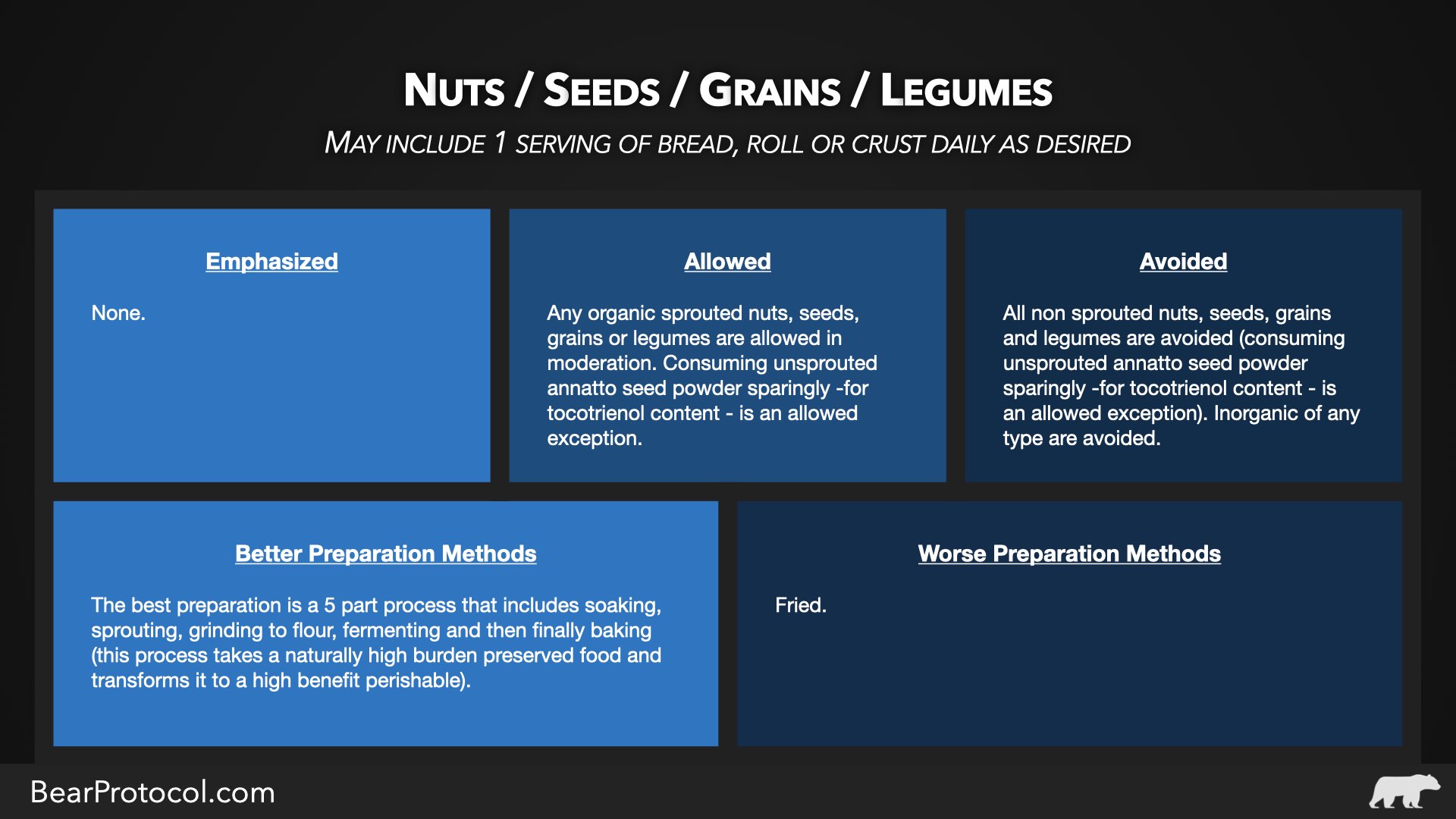
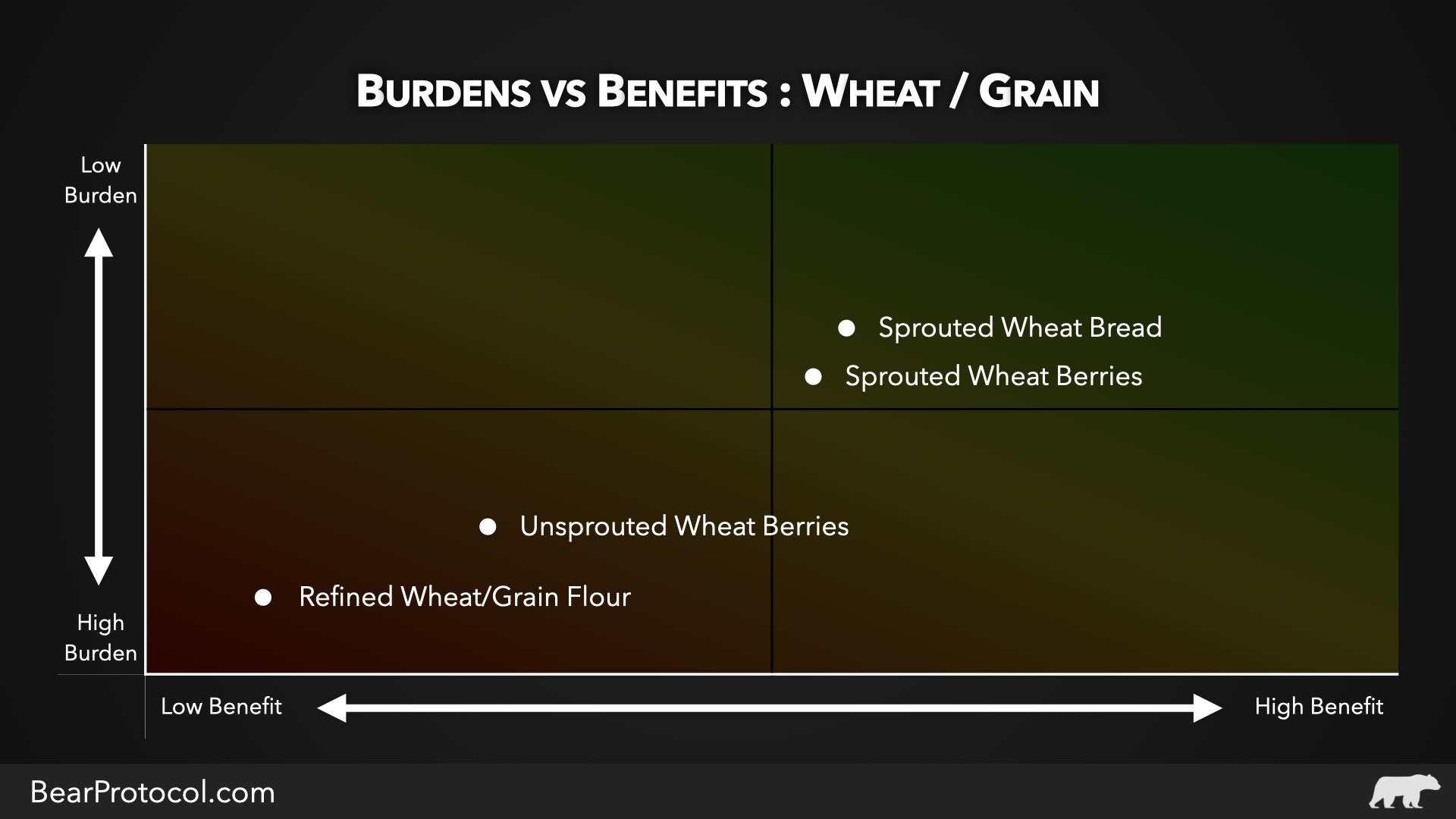
Nuts, seeds, grains and legumes are (at least as they’re used in the modern/western way) the worst possible foods to consume. This is for multiple reasons. First, they’re often not used in their whole form as they usually have the bran and/or germ removed. Secondly, they’re rarely sprouted before being made into flour. Third they’re often used without fermentation to make crackers, pancakes, waffles, cookies, muffins, cakes, pasta cereals, doughnuts and so much more.
This is heartbreaking …
To demonstrate the point of how much of a burden these foods are on your body’s precious resources. Simply take a handful of nuts, seeds, grains, and legumes and leave them in the pantry or on the counter. Observe how that handful of food is preserved and remains for days and even months with little to no sign of decay.
Compare that to a handful of fresh ripe fruit, vegetables, or meat.
The nuts, seeds, grains and legumes don’t pass the “perishable” test. And therefore must be avoided as they have a much larger burden on rather than benefit to the body’s precious resources.
THERE IS A SOLUTION AND EXCEPTION!!
Consider taking a handful of the same wheat berries that didn’t break down for months. Now soak a cup of them in water for 24 hours. Be sure to rinse them every 8 hours during the soak. You’ll notice they’ve begun to sprout at the end of the soak. Next, dry them out to become sprouted wheat berries. Now they can be ground into sprouted wheat flour. Use this flour to make a fermented bread dough. Finally, bake the dough to make delicious bread. Cut a slice of your delicious bread and leave it on the counter. What happens?
Your fresh homemade bread becomes stale in hours and moldy and rotten in less than days. It passes the “perishable” test.
So … let’s note the 5 criteria for eating nuts, seeds, grains, or legumes,
- Soaking:
- Sprouting:
- Grinding:
- Fermenting:
- Baking:
This means say goodbye to the high burden of crackers, pancakes, waffles, cookies, muffins, cakes, pastas, cereals, doughnuts etc. etc.
And say hello to the nutrient-dense sprouts that can be used to make bread, rolls or pizza crust.
How and When to Eat
It’s shockingly good news to many that bread, rolls and crusts can be part of a healthy diet. After all, many restricted diets don’t acknowledge the vast difference between non-whole unsprouted unfermented grains and the nutrient-rich and perishable sprouted fermented bread, rolls and crusts.
BUT THERE ARE TWO IMPORTANT GUIDELINES
Moderation: Just because you can eat bread or toast or rolls doesn’t mean they should be the priority or should take the place of meats, eggs, berries, or leafy greens. It’s important to note that even when prepared properly these foods should be roughly 1/16 of your diet. So enjoy the bread, roll or crust but don’t allow it to become a foundational part of your diet.
Pairing and Order: Another important note is that you want to keep your body from having any unnecessary rise in blood glucose. This means that your slice of toast or roll should not be eaten alone as a snack (which raises your blood glucose). But should always be paired with a fat and protein-rich meal AND EQUALLY IMPORTANTLY should not be eaten alone at the beginning of that meal but with your servings of fats and/or proteins or at the end of the meal (which has little to no impact on blood glucose – depending on the sprouted flour used and how much).
Here’s the list of nuts, seeds, grains and legumes that are more commonly used to make sprouted flours and their breads, rolls or crusts:
- Sprouted Wheat Flour
- Sprouted Spelt Flour
- Sprouted Barley
- Sprouted Millet
- Sprouted Buckwheat Flour
- Sprouted Quinoa Flour
- Sprouted Almond Flour
- Sprouted Lentil Flour
- Sprouted Soybean Flour
- Sprouted Chickpea Flour (Besan)
- Sprouted Sunflower Seed Flour
Ezekiel Bread
A popular choice for sprouted bread is Ezekiel bread which is the recipe mentioned in the book of Ezekiel in the bible. This bread includes the following sprouted grains and legumes:
- Wheat
- Millet
- Barley
- Spelt
- Beans (commonly soybeans presently but further research needed on which beans were used biblicly)
- Lentils
How Much of Each Food Group
When To Eat
An Ideal schedule would be something close to waking up naturally from the sun. Exercise. Then eat a full satisfying breakfast. And by full I mean an abundance of all the nutrients for healing (we can discuss in detail later – for now follow the daily guidelines to get an abundance of the critical nutrients).
Hopefully, you’re hungry again by sunset and you have a full and satisfying dinner. Once the sunsets, your fast begins and it should be only water (or water with electrolytes if needed) until breakfast.
If two meals a day isn’t best for you. One meal a day or three meals a day are equally fine. Just eat when the sun is up. And fast while the sun is down. This might mean three meals in the summer and only two in the winter. Find what works for you.
Is there an exception?
If you have a chronic or terminal illness that falls within the second phase of the cell danger response (CDR2), you may want to stay in a fasting state longer. For example, one might try keeping all meals within a narrower four or six-hour window and have a 20-hour or 18-hour fast.
The Daily Guidelines
Fatty Fish: Fatty fish should be consumed 3-7 times per week. Fatty fish include salmon, trout, mackerel, herring, sardines, cod, or anchovies. Both the DHA and EPA are needed in abundance for healing. If it can be eaten daily – FANTASTIC. If it can only be eaten every other day – then on the ‘off’ days it should be replaced with non-fatty fish, other seafood, an organ meat, grassfed beef, or free-range chicken.
Green Juice: A green juice should be consumed every day. The ideal recipe would include one or two large beets and any number of the super seven cruciferous greens. In total the greens should equal no less than a head of lettuce. All the greens can come from your single favorite green or you can do a little of each of the seven or anything in between. Consuming the green juice with the same meal as your fatty fish is a biochemical healing party!
Collagen and Whey: Both hydrolyzed collagen and hydrolyzed whey should be consumed at least once daily. Twice is even better. The glycine from hydrolyzed collagen and cysteine from hydrolyzed whey is critical in glutathione synthesis, healing, and detoxification.
Eggs: Eggs should be consumed at least once per day. They are a fantastic way to get your much-needed choline. Additionally, eggs will provide the AA needed for an SPM (specialized pro-resolving mediator) that originates from AA.
Fruits and Vegetables: Greens should be consumed at every meal. These include leafy greens, baby greens, micro greens, sprouts, shoots, grasses, or whatever else you want to call them. Bonus points if some of your greens are cruciferous greens (AKA the super seven). Juicing is the easiest way to get these greens in abundance. You should have no less than one green juice per day. But you should also add greens to your omelets, smoothies, and use them to make soups and salsas. And you can always have them steamed or even raw. Fruits don’t have a daily requirement, instead, be mindful you don’t eat them on an empty stomach, at the beginning of a meal or with a meal absent of a high protein and high-fat food.
Flaxseed Oil: At least 2-3 teaspoons of flaxseed oil should be consumed daily. This is how you’ll ensure you get your very powerful, anti-inflammatory and essential ALA Omega-3 fatty acid.
Fermented Foods: Fermented foods can be tricky. You may not tolerate them if you are not in optimal health. You should, however, when or as soon as tolerated, consume them in at least a small amount daily. Fermented dairy and bread would be great to pair in the same meal. The probiotics of the fermented dairy feed on the prebiotics of the fermented bread and provide a boost in B vitamins. As time goes on, and as you tolerate more, you should try for at least one full serving of fermented dairy each day. BUT when it comes to bread this should be limited to a single slice per day or less. And yes that slice of fermented bread can be the bottom half of a scrumptious slice of pizza. I know, it feels like there’s no way pizza belongs in a healthy diet! There’s such a thing. Just follow what you know about healthy eating.
The Perfect Meal Plan
So what does an ideal meal plan look like in a day on the bear diet?
